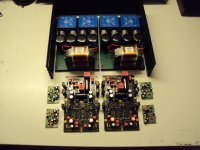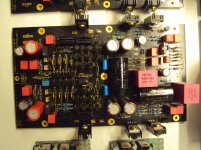Hi Joachim,
I understand a double cascode, but why a triple cascode in this case? I assume the pot is to achieve low DC offset?
The loading before the buffer looks complex. Was this a circuit designed in simulation? From what I know of similar circuitry, this can be mighty fast.
-Chris
I understand a double cascode, but why a triple cascode in this case? I assume the pot is to achieve low DC offset?
The loading before the buffer looks complex. Was this a circuit designed in simulation? From what I know of similar circuitry, this can be mighty fast.
-Chris
Higher output impedance against the RIAA components.
That gives more forward gain and reduces distortion with the RIAA loaded.
It is a kind of local current feedback, call it degeneration.
This circuit is more temperature stable then the ones before.
The double cascode also gives better PSRR i think.
That gives more forward gain and reduces distortion with the RIAA loaded.
It is a kind of local current feedback, call it degeneration.
This circuit is more temperature stable then the ones before.
The double cascode also gives better PSRR i think.
The upper transistors form a CCS. That gives more gain.
The loading are the RIAA components. They form a frequency dependent voltage devider.
We have discussed this option in the Paradise circuit.
What i like with this circuit is that distortion falls with frequency and level.
I call that monotonic. It is a bit like the ear.
High negative feedback circuits are kind of the oposite although distortion in an absolute sense can be extremely low ( Opamps ).
The loading are the RIAA components. They form a frequency dependent voltage devider.
We have discussed this option in the Paradise circuit.
What i like with this circuit is that distortion falls with frequency and level.
I call that monotonic. It is a bit like the ear.
High negative feedback circuits are kind of the oposite although distortion in an absolute sense can be extremely low ( Opamps ).
Usually with a folded cascode w/CCS most of the gain is lost through the C-B junction, not through the emitter. So adding another cascode would just mean the gain is lost through the new cascode's base. A Hawksford or Baxandall cascode would perform that function better.
The C1815/A1015 simulator models are probably not any good.
It looks like R20 makes R18 act like a 2200k resistor.
The C1815/A1015 simulator models are probably not any good.
It looks like R20 makes R18 act like a 2200k resistor.
The problem with the Hawsford and Baxandall is that you run into DC offset.
A small mismatch makes the supply patently clamp to one side.
Maybe the circuit can be bettered but it works very well and sounds good with a real simple design.
When we made the Paradise we ran into the same problem :
A " too good " mirror made the circuit nearly imposible to stabilize.
I made a version of the Paradise called Opus Magnum. It was DC coupled and had a Gilbert 2 I mirror. That mirror can be ( theoretical ) set to infinite output impedance.
We needed several years with 4 engineers to stabilize it. We had to give up much of the output impedance by modifying the circuit, even with servo. That teached me a lot of what is desirable and what is managegable.
A small mismatch makes the supply patently clamp to one side.
Maybe the circuit can be bettered but it works very well and sounds good with a real simple design.
When we made the Paradise we ran into the same problem :
A " too good " mirror made the circuit nearly imposible to stabilize.
I made a version of the Paradise called Opus Magnum. It was DC coupled and had a Gilbert 2 I mirror. That mirror can be ( theoretical ) set to infinite output impedance.
We needed several years with 4 engineers to stabilize it. We had to give up much of the output impedance by modifying the circuit, even with servo. That teached me a lot of what is desirable and what is managegable.
Last edited:
Yes this kind of circuit need very very special housekeeping, one that at the same time sets the current through the IPS transistor pairs and also locks the current in the cacsocdes, any imbalance there send the output to the rails. tricky circuit, but with great potential.
All resistors sound slightly different.
The naked foils are the most transparent, some whould say bright.
On the other end are the big Dales that sound slightly warm.
This effects are small. When you read about huge differences in resistors you should be sceptical. I talk about low noise resistors here, metal film and metal foil.
Carbon can be a problem with noise and wire wound can have high inductance.
The naked foils are the most transparent, some whould say bright.
On the other end are the big Dales that sound slightly warm.
This effects are small. When you read about huge differences in resistors you should be sceptical. I talk about low noise resistors here, metal film and metal foil.
Carbon can be a problem with noise and wire wound can have high inductance.

